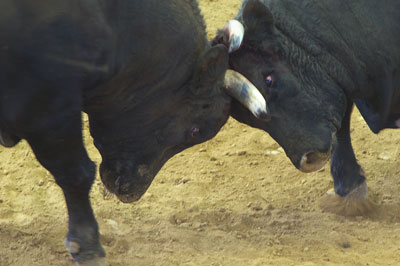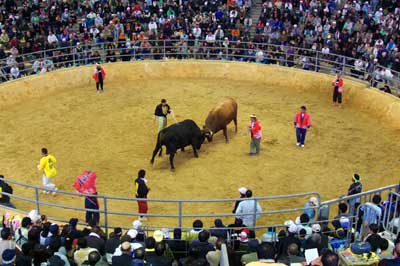
An Okinawan Bullfight
This Bullfight in Uruma Okinawa, Japan was part of the festivities associated with the Lunar, or Chinese New Year on the 1st of February 2009. According to the Asian calendars, it is the Year of the Ox.
Unlike bullfighting in Spanish speaking cultures, there is no Matador to face the bull; it is one bull challenging another and neither will be seriously injured or die in the event.
The arena was a dome-shaped structure with open sides, to provide air circulation. A circular area covered with a mixture of sand and clay, about 18 meters in diameter, is where the bulls face each other. It is surrounded by an earthen mound and topped with an iron fence railing. Completely around and above the bullfighting ring are concrete bleachers with enough seating for a few thousand expectant spectators. A tunnel, under the bleachers, is the only way for bulls and their handlers to enter and exit the ring.
There may be a team of handlers in the ring for each bull but, only one member at a time is permitted to physically handle their bull. The rest of the team stays back at a distance, ready to relieve a handler as required. The less experienced bulls are led on a line tethered through their noses. Bulls with the most experience are not tethered, as they do not need to be led–they actually look forward to the fight.
Judges, seated above the arena, determine the winner and looser of each bout when a decision needs to be made, but usually, the bulls decide for themselves. Normally, whichever bull runs away from the fight is the looser. However, sometimes a bull will break free and run, only to gain enough momentum to turn around and charge his opponent and win the match.

A normal bout lasts around ten minutes with the bulls locking horns and trying to muscle their opponent into quitting. They get tired much as a couple of arm-wrestlers would and usually one bull will just give up, turn and run, thus ending the match. Sometimes a bull will be intimidated when he first sees his opponent and just run for the exit without ever starting to fight. The hecklers in the crowd go wild ! Then, there are the bouts of great courage and stamina that last twenty to thirty minutes. The unpredictability of each match is what the crowds come to see.
With their heads and horns as their only weapons, one would think this might be a bloody sport, but it isn’t. The judges and handlers would quickly end any match where serious injury might occur. The handlers actually treat their bulls as family pets. Some of them go through the bout barefooted while standing right next to their bull, patting its shoulder and speaking encouraging words while its locking horns with another ton of snorting, earth-pawing bull!
At the end of each bout the loosing bull is quickly escorted to the exit by its team of handlers. But the winning bull is regaled with attention by its team members and the celebrating fans–has a colorful cape placed on its back and bright colored ribbons and towels tied to its horns and tail. Then he is paraded around the ring in all of his glory, stopping only for children, family members and the handlers–they are allowed to jump on his back for a victory photo. Loud, Okinawan traditional music is played until the victor leaves the ring. The crowd cheers and applauds until the bull is out of sight
Then, the music abruptly stops.
The crowd becomes silent in anticipation of the upcoming match.
The announcer calls for the next teams…
by Michael Lynch
Story and photos: © 2009 Michael Lynch. All rights reserved.

Leave a Reply